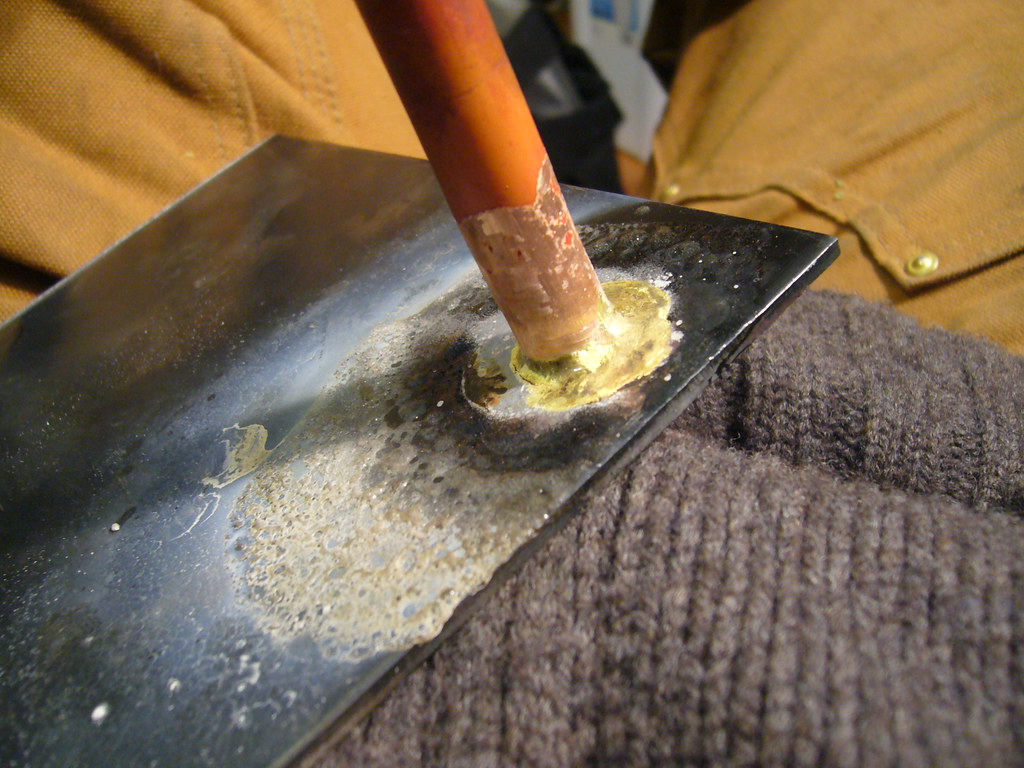While researching something else the other day, I came across a few people wondering how to join copper and steel. I had to do this once and had great success using this method, so much so that I've used it a few times since.
--
I use Gasflux C-04 nickel bronze in 3/32" diameter, along with their Type B blue paste flux. These should be available through Airgas on the East Coast. Low-fuming bronze from the local welding store is not at all the same thing.
Copper, being much more thermally conductive than steel, quickly sucks heat away from the joint. So if the copper you're brazing is connected to more copper, be prepared to heat up the whole mess, which can take a lot of heat.
Conversely, steel is slow to disperse heat, so you may want to preheat the steel to avoid overheating the copper, especially if there's a lot of steel and not so much copper. By the time the steel comes up to temp, the copper may be hot enough to flow brazing filler, just from being around the steel.
All that said, this is not a very hard joint to braze. If you've done blacksmithing or basic MIG or stick welding, this would be a lot easier to learn than TIG. A quick practice joint or two would suffice for training.
There are other ways to join copper and steel, like silver soldering, but this method may create a stronger joint than silver, especially in a tee or butt joint. Bronze fillers (like C-04) are better for filling gaps than silver fillers.
This method works especially well for brazing copper tube passing through a hole in sheet steel. The hole need not have a perfect clearance fit around the pipe, and the tube need not be perfectly centered in the hole.
As in all brazing operations, freshly-sanded, clean, oil-free parent metals are highly recommended.
If the copper gets too hot, it'll open up a hole, which would likely mean replacing the copper, so watch out for that.
Discoloration of the copper is normal and can be easily removed with abrasives like Scotch-Brite and emery roll.
Copper anneals at temperatures well below brazing temperatures. Be prepared for the copper to soften considerably.
I've always used oxy-acetylene, but oxy-propane would surely work.
UPDATE: Here's an example.
Not my absolute best work, but good enough. Flux was applied to the steel only in a small circle, hence the black oxidation everywhere.
Subscribe to:
Post Comments (Atom)




2 comments:
It is important when using copper fittings not to tighten them too much; overbearing pressure can damage the fitting or bend the pipe, making them unusable or leaky. Compression fittings are single-use only; once attached to a pipe, it is usually attached for good. If improperly installed, you must cut the piping around the fitting to remove it and purchase a new copper compression fitting.
One problem I encountered early on in my artist endeavors was trying to brazing brass to steel or to brass for that matter with ordinary bronze brazing rod. Problem with this is your common brass has a melting point approximately the same as your brazing rod. That is somewhere in the 1700 to 1800 Fahrenheit neighborhood. Another peculiarity about heating brass is that it does not "flow" or liquefy like bronze, silver or iron for that matter. At bright red heat it oxidizes extensively and gets a coating of black,green, and brown oxides. Whats more, is that if you are not diligent when heating the brass, after the oxidizing begins the metal will either collapse into a puddle or shrivel into a hideous form similar to what aluminum does. Another dilemma is that you may inadvertently burn a hole in the brass if it is a relatively thin plate or sheet metal.
brazing equipment singapore
Post a Comment